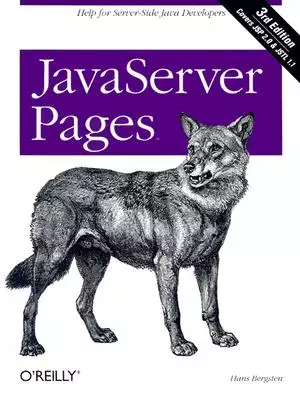JSP if tag的問題,我們搜遍了碩博士論文和台灣出版的書籍,推薦Bergsten, Hans寫的 Javaserver Pages 可以從中找到所需的評價。
國立臺北大學 都市計劃研究所 黃書禮、詹士樑所指導 廖珮伃的 綠色基盤的逕流分擔對洪災潛勢影響之研究-以三重蘆洲地區為例 (2018),提出JSP if tag關鍵因素是什麼,來自於綠色基盤、逕流分擔、SCS逕流曲線法、洪災潛勢、設計型態。
而第二篇論文國立臺灣科技大學 管理研究所 盧希鵬所指導 張成秀的 設計智慧具社交功能的科技以協助活躍老化 - 從預防的觀點出發 (2017),提出因為有 活躍老化、社會支持、語音使用者介面、社交機器人、戰後嬰兒潮、穿戴式運動裝置的重點而找出了 JSP if tag的解答。
Javaserver Pages

為了解決JSP if tag 的問題,作者Bergsten, Hans 這樣論述:
JavaServer Pages (JSP) has built a huge following since the release of JSP 1.0 in 1999, providing Enterprise Java developers with a flexible tool for the development of dynamic web sites and web applications. While new point releases over the years, along with the introduction of the JSP Standard Ta
g Library (JSTL), have incrementally improved the rough areas of the first version of the JSP specification, JSP 2.0 takes this technology to new heights.JavaServer Pages, Third Edition, is completely revised and updated to cover the JSP 2.0 and JSTL 1.1 specifications. It includes detailed coverage
of the Expression Language (EL) incorporated into JSP 2.0, the JSTL 1.1 tag libraries and the new function library, the new tag file format that enables custom tag library development without Java code, the simplified Java tag library API, improvements in the JSP XML syntax, and more. Further, it d
etails setup of the Apache Tomcat server, JSP and JSTL syntax and features, error handling and debugging, authentication and personalization, database access, XML processing, and internationalization.This book recognizes the different needs of the two groups of professionals who want to learn JSP: p
age authors interested in using JSP elements in web pages, and programmers concerned with learning the JSP API and using JSP effectively as a part of an enterprise application. If you're in the first group, you'll learn from the practical web application examples in the second part of the book. If y
ou're in the latter group, you'll appreciate the detailed coverage of advanced topics in the third part, such as how to integrate servlets and JavaBeans components with JSP using the popular Apache Struts MVC framework, and how to develop custom tag libraries using the JSP API, with realistic exampl
es that you can use as a springboard for your own libraries."Hans Bergsten, a JSP expert group veteran and one of our most active contributors, has thoroughly and accurately captured the new features of JSP 2.0 and JSTL 1.1 in a way that is well-organized and easy to understand. With excellent, to-t
he-point examples, this book is a 'must have' for any serious JSP 2.0 developer."--Mark Roth, JSP 2.0 Specification Lead, Sun Microsystems, Inc.Hans Bergsten is the founder of Gefion Software, a company focused on Java services and products based on J2EE technologies. Hans has been an active partici
pant in the working groups for both the servlet and JSP specifications since their inception and contributes to other related JCP specifications, such as JSP Standard Tag Library (JSTL) and JavaServer Faces (JSF), and, as one of the initial members of the Apache Jakarta Project Management Committee,
helped develop the Apache Tomcat reference implementation for the servlet and JSP specifications. Hans Bergsten is the founder of Gefion Software, a company focused on Java services and products based on the J2EE technlogies. Hans has been an active participant in the working groups for both the
servlet and JSP specifications from the time they were formed. He also contributes to other related JCP specifications, such as JSP Standard Tag Libraries (JSTL), and helped get the development of the Apache Tomcat reference implementation for servlet and JSP started as one of the initial members of
the Apache Jakarta Project Management Committee.
綠色基盤的逕流分擔對洪災潛勢影響之研究-以三重蘆洲地區為例
為了解決JSP if tag 的問題,作者廖珮伃 這樣論述:
導因於近年來都市高度發展,都市中因大面積土地皆被不透水層覆蓋,減少雨水下滲至土壤之機會,使其必須仰賴排水系統與防洪工程幫助免於發生洪災,然近年來短延時強降雨發生頻率愈趨增加,倘若遇到超越其承洪極限之降雨,都市將面臨更大的災害風險。在此背景下,逕流分擔概念強調將原由水道所容納之逕流量,改變由水道與土地共同分擔,達到分散逕流與增加貯留空間。綠色基盤(Green Infrastructure)種類包含塊狀的保護區、森林、農田、公園與線狀的河流、綠帶、生態廊道等,同時亦為分散式的雨水管理網絡,如綠屋頂、樹木、雨水花園、透水鋪面,在提供休閒遊憩、活動功能的同時也透過吸收與入滲來減少地表逕流。藉
由其作為暫時性的貯留、分擔逕流之空間,為此,綠色基盤的設計型態是否有助於發揮逕流分擔之效果將扮演重要角色。 本研究為探討綠色基盤的設計型態對逕流之影響,以三重蘆洲地區為例,由於其為高度發展之都市地區,本研究僅聚焦於討論屬綠色基盤中塊狀的公園與學校設計型態對逕流之影響。使用SCS逕流曲線法取得逕流深度之分布,爾後針對公園綠地廣場、學校之設計型態進行實地的調查,並作為情境設計之依據,最後透過三個不同情境之模擬,檢視與比較在不同的情境下逕流分擔之效果與降低洪災潛勢的效益,進而進行分析與討論。 研究結果顯示透過改變綠色基盤之設計型態,具有顯著的降低洪災潛勢之效果,並能同時提高綠色基盤之逕流
分擔效率,其中透過同時實施透水鋪面與下凹式設計設施,則對降低洪災潛勢與提高逕流分擔效率有最好的效果,亦能說明透過對公共設施的規劃設計進行改變,已能明顯對洪災潛勢達到降低效果。期望研究成果提供於未來進行都市計畫通盤檢討、土地使用管制中擬定與防洪減災相關的決策,亦或是檢討與盤點公共設施、開放空間時,得以納入之規劃設計參考與建議。
設計智慧具社交功能的科技以協助活躍老化 - 從預防的觀點出發
為了解決JSP if tag 的問題,作者張成秀 這樣論述:
全球老化是一個台灣也無法倖免的現象,日本仍然是老化率最高的國家,到了 2025 年,60歲以上的人口將占其總人口35%。但是中國正快速成為老化人口最多的國家,歸因於其一胎化政策,到了 2025 年,60歲以上的人口將高達兩億八千七百萬(世界衛生組織,2003)。台灣正飛速追趕,屆時會是超高齡社會之一,亦即60歲以上的人口將占其總人口20% (國家發展委員會,2016)。然而,活得久並不保證活得好。根據衛福部統計資料顯示:台灣人在往生前平均臥床年數近九年(衛福部,2015)。以上都是世界衛生組織會在2003年制定活躍老化作為世界各國公共政策的總綱的原因,以因應銀髮浪潮的各樣挑戰。活躍老化的定義
是在人年長的過程,能在健康、社會參與與安全保障各方面掌握機會來增進生活品質的過程 (世界衛生組織,2003)。世界衛生組織在其第十一屆世界論壇中揭櫫了這三個活躍老化的重要支柱,這也成為本研究的基礎架構。第一篇:活躍老化的系統化文獻探討:2000-2014年 SSCI 的學術文獻此篇為深入的文獻探討,找出二十一世紀對活躍老化學術研究的缺口。第二篇:質化研究:影響體能活動的穿戴裝置與社會支持間彼此強化的作用此篇為針對活躍老化的重要支柱:健康這個面向所做的質化研究,探討穿戴裝置如何能促進體能活動。第三篇:刻板印象或是黃金法則?台灣善用科技的戰後嬰兒潮對具社交功能機器人聲音之偏好研究此篇為針對活躍老化
另一個的重要支柱:社會參與這個面向所做的量化研究,探討善用科技的戰後嬰兒潮會喜歡的聲音,做為具社交功能機器人的人機介面,進而促進其社會參與。